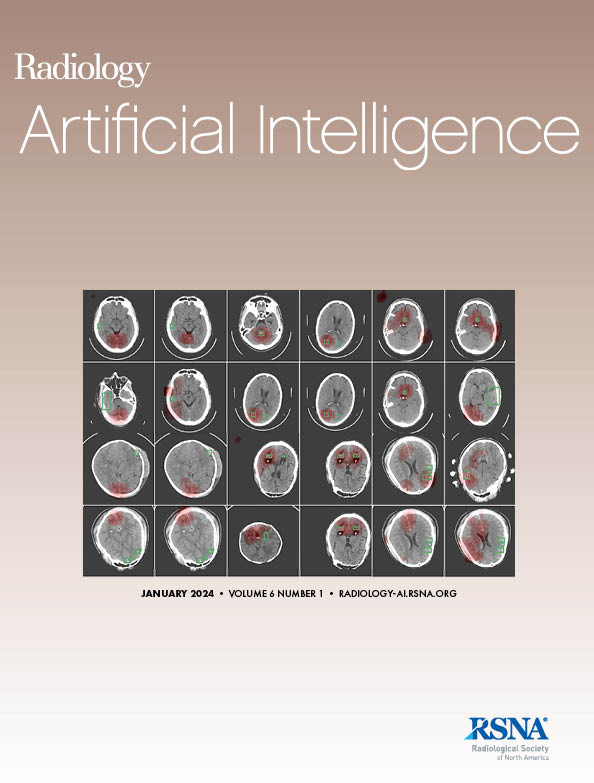Chaowei Wu, Lixia Wang, Nan Wang, Stephen Shiao, Tai Dou, Yin-Chen Hsu, Anthony G Christodoulou, Yibin Xie, Debiao Li
下载PDF
{"title":"Prediction of Early Neoadjuvant Chemotherapy Response of Breast Cancer through Deep Learning-based Pharmacokinetic Quantification of DCE MRI.","authors":"Chaowei Wu, Lixia Wang, Nan Wang, Stephen Shiao, Tai Dou, Yin-Chen Hsu, Anthony G Christodoulou, Yibin Xie, Debiao Li","doi":"10.1148/ryai.240769","DOIUrl":null,"url":null,"abstract":"<p><p>Purpose To improve the generalizability of pathologic complete response prediction following neoadjuvant chemotherapy using deep learning-based retrospective pharmacokinetic quantification of early treatment dynamic contrast-enhanced MRI. Materials and Methods This multicenter retrospective study included breast MRI data from four publicly available datasets of patients with breast cancer acquired from May 2002 to November 2016. Pharmacokinetic quantification was performed using a previously developed deep learning model for clinical multiphasic dynamic contrast-enhanced MRI datasets. Radiomic analysis was performed on pharmacokinetic quantification maps and conventional enhancement maps. These data, together with clinicopathologic variables and shape-based radiomic analysis, were subsequently applied for pathologic complete response prediction using logistic regression. Prediction performance was evaluated by area under the receiver operating characteristic curve (AUC). Results A total of 1073 female patients with breast cancer were included. The proposed method showed improved consistency and generalizability compared with the reference method, achieving higher AUC values across external datasets (0.82 [95% CI: 0.72, 0.91], 0.75 [95% CI: 0.71, 0.79], and 0.77 [95% CI: 0.66, 0.86] for datasets A2, B, and C, respectively). For dataset A2 (from the same study as the training dataset), there was no significant difference in performance between the proposed method and reference method (<i>P</i> = .80). Notably, on the combined external datasets, the proposed method significantly outperformed the reference method (AUC, 0.75 [95% CI: 0.72, 0.79] vs AUC, 0.71 [95% CI: 0.68, 0.76]; <i>P</i> = .003). Conclusion This work offers an approach to improve the generalizability and predictive accuracy of pathologic complete response for breast cancer across diverse datasets, achieving higher and more consistent AUC scores than existing methods. <b>Keywords:</b> Tumor Response, Breast, Prognosis, Dynamic Contrast-enhanced MRI <i>Supplemental material is available for this article.</i> © RSNA, 2025 See also commentary by Schnitzler in this issue.</p>","PeriodicalId":29787,"journal":{"name":"Radiology-Artificial Intelligence","volume":" ","pages":"e240769"},"PeriodicalIF":13.2000,"publicationDate":"2025-09-01","publicationTypes":"Journal Article","fieldsOfStudy":null,"isOpenAccess":false,"openAccessPdf":"https://www.ncbi.nlm.nih.gov/pmc/articles/PMC12464716/pdf/","citationCount":"0","resultStr":null,"platform":"Semanticscholar","paperid":null,"PeriodicalName":"Radiology-Artificial Intelligence","FirstCategoryId":"1085","ListUrlMain":"https://doi.org/10.1148/ryai.240769","RegionNum":0,"RegionCategory":null,"ArticlePicture":[],"TitleCN":null,"AbstractTextCN":null,"PMCID":null,"EPubDate":"","PubModel":"","JCR":"Q1","JCRName":"COMPUTER SCIENCE, ARTIFICIAL INTELLIGENCE","Score":null,"Total":0}
引用次数: 0
引用
批量引用
Abstract
Purpose To improve the generalizability of pathologic complete response prediction following neoadjuvant chemotherapy using deep learning-based retrospective pharmacokinetic quantification of early treatment dynamic contrast-enhanced MRI. Materials and Methods This multicenter retrospective study included breast MRI data from four publicly available datasets of patients with breast cancer acquired from May 2002 to November 2016. Pharmacokinetic quantification was performed using a previously developed deep learning model for clinical multiphasic dynamic contrast-enhanced MRI datasets. Radiomic analysis was performed on pharmacokinetic quantification maps and conventional enhancement maps. These data, together with clinicopathologic variables and shape-based radiomic analysis, were subsequently applied for pathologic complete response prediction using logistic regression. Prediction performance was evaluated by area under the receiver operating characteristic curve (AUC). Results A total of 1073 female patients with breast cancer were included. The proposed method showed improved consistency and generalizability compared with the reference method, achieving higher AUC values across external datasets (0.82 [95% CI: 0.72, 0.91], 0.75 [95% CI: 0.71, 0.79], and 0.77 [95% CI: 0.66, 0.86] for datasets A2, B, and C, respectively). For dataset A2 (from the same study as the training dataset), there was no significant difference in performance between the proposed method and reference method (P = .80). Notably, on the combined external datasets, the proposed method significantly outperformed the reference method (AUC, 0.75 [95% CI: 0.72, 0.79] vs AUC, 0.71 [95% CI: 0.68, 0.76]; P = .003). Conclusion This work offers an approach to improve the generalizability and predictive accuracy of pathologic complete response for breast cancer across diverse datasets, achieving higher and more consistent AUC scores than existing methods. Keywords: Tumor Response, Breast, Prognosis, Dynamic Contrast-enhanced MRI Supplemental material is available for this article. © RSNA, 2025 See also commentary by Schnitzler in this issue.
基于深度学习的DCE MRI药代动力学量化预测乳腺癌早期新辅助化疗反应
“刚刚接受”的论文经过了全面的同行评审,并已被接受发表在《放射学:人工智能》杂志上。这篇文章将经过编辑,布局和校样审查,然后在其最终版本出版。请注意,在最终编辑文章的制作过程中,可能会发现可能影响内容的错误。目的利用基于深度学习(DL)的早期治疗动态对比增强(DCE) MRI回顾性药代动力学量化(RoQ)提高新辅助化疗后病理完全缓解(pCR)预测的泛化性。材料与方法本多中心回顾性研究纳入了2002年5月至2016年11月期间获得的四个公开数据集的乳腺癌患者的乳房MRI数据。RoQ使用先前开发的临床多相DCE-MRI数据集的DL模型进行。对RoQ图和常规增强图进行放射学分析。这些数据,连同临床病理变量和基于形状的放射组学分析,随后应用逻辑回归进行pCR预测。用受试者工作特征曲线下面积(AUC)评价预测效果。结果共纳入1073例女性乳腺癌患者。与参考方法相比,该方法具有更好的一致性和通用性,在外部数据集上获得更高的auc(数据集A2、B和C分别为0.82 [CI: 0.72-0.91]、0.75 [CI: 0.71-0.79]和0.77 [CI: 0.66-0.86])。在数据集A2(来自与训练数据集相同的研究)上,所提出的方法与参考方法在性能上没有显著差异(P = 0.80)。值得注意的是,在合并的外部数据集上,该方法显著优于参考方法(AUC: 0.75 [CI: 0.72- 0.79] vs 0.71 [CI: 0.68-0.76], P = 0.003)。这项工作提供了一种新的方法来提高乳腺癌pCR反应在不同数据集中的普遍性和预测准确性,获得比现有方法更高和更一致的AUC评分。©RSNA, 2025年。
本文章由计算机程序翻译,如有差异,请以英文原文为准。

 求助内容:
求助内容: 应助结果提醒方式:
应助结果提醒方式:


